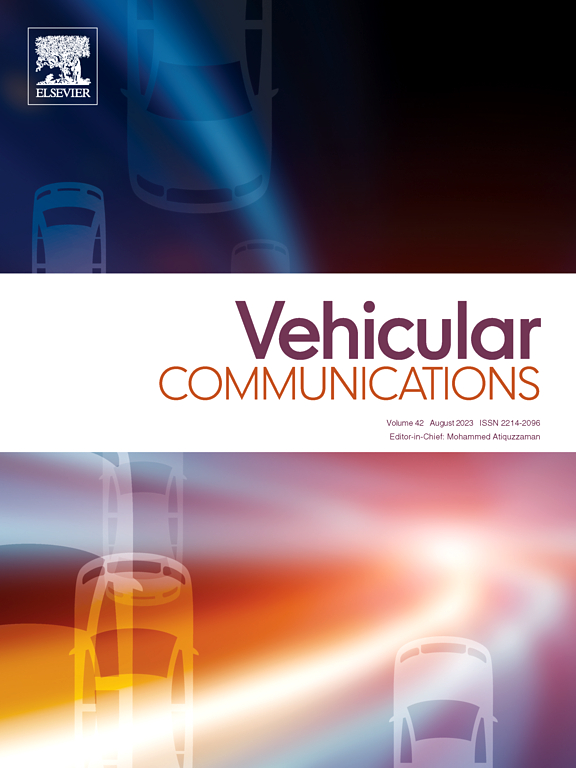Modelling, optimisation and evaluation of multi-transmitters FSO link for ground to train communication
IF 6.5
2区 计算机科学
Q1 TELECOMMUNICATIONS
引用次数: 0
Abstract
This paper investigates the potential of Free Space Optical (FSO) communication technology for high-speed train (HST) systems by developing mathematical models for G2T-FSO (Ground to Train) communication links across single, curved, and double-curved tracks. The key contribution of this research is the introduction of novel G2T-FSO models, incorporating multiple transmitters (single, double, triple, and quad) and considering different weather conditions (clear, rain, and fog) using NRZ-OOK modulation. The models were evaluated based on key performance metrics, including received power, signal-to-noise ratio (SNR), bit error rate (BER), and eye diagrams. Simulation results reveal that single and dual transmitter links are significantly impacted by geometrical and atmospheric losses, while triple and quad transmitters provide error-free G2T-FSO links with a BER of 10-9. Under clear weather conditions, communication ranges of up to 680 meters for straight tracks and 618 meters for curved tracks were achieved. These findings highlight that G2T-FSO links deliver superior performance compared to traditional HST communication technologies, offering enhanced range, reliability, and data capacity for high-speed, secure train communication systems.
地面到训练通信的多发射机FSO链路建模、优化和评估
本文通过建立G2T-FSO(地对列车)通信链路的数学模型,研究了高速列车(HST)系统中自由空间光学(FSO)通信技术的潜力。本研究的主要贡献是引入了新型G2T-FSO模型,该模型结合了多个发射机(单、双、三和四),并使用NRZ-OOK调制考虑了不同的天气条件(晴朗、下雨和雾)。根据关键性能指标对模型进行评估,包括接收功率、信噪比(SNR)、误码率(BER)和眼图。仿真结果表明,单发射机和双发射机链路受到几何和大气损耗的显著影响,而三发射机和四发射机提供无差错的G2T-FSO链路,误码率为10-9。在天气晴朗的情况下,直道通信距离可达680米,弯道通信距离可达618米。这些发现强调,与传统的HST通信技术相比,G2T-FSO链路提供了卓越的性能,为高速、安全的列车通信系统提供了更大的范围、可靠性和数据容量。
本文章由计算机程序翻译,如有差异,请以英文原文为准。
求助全文
约1分钟内获得全文
求助全文
来源期刊

Vehicular Communications
Engineering-Electrical and Electronic Engineering
CiteScore
12.70
自引率
10.40%
发文量
88
审稿时长
62 days
期刊介绍:
Vehicular communications is a growing area of communications between vehicles and including roadside communication infrastructure. Advances in wireless communications are making possible sharing of information through real time communications between vehicles and infrastructure. This has led to applications to increase safety of vehicles and communication between passengers and the Internet. Standardization efforts on vehicular communication are also underway to make vehicular transportation safer, greener and easier.
The aim of the journal is to publish high quality peer–reviewed papers in the area of vehicular communications. The scope encompasses all types of communications involving vehicles, including vehicle–to–vehicle and vehicle–to–infrastructure. The scope includes (but not limited to) the following topics related to vehicular communications:
Vehicle to vehicle and vehicle to infrastructure communications
Channel modelling, modulating and coding
Congestion Control and scalability issues
Protocol design, testing and verification
Routing in vehicular networks
Security issues and countermeasures
Deployment and field testing
Reducing energy consumption and enhancing safety of vehicles
Wireless in–car networks
Data collection and dissemination methods
Mobility and handover issues
Safety and driver assistance applications
UAV
Underwater communications
Autonomous cooperative driving
Social networks
Internet of vehicles
Standardization of protocols.
 求助内容:
求助内容: 应助结果提醒方式:
应助结果提醒方式:


